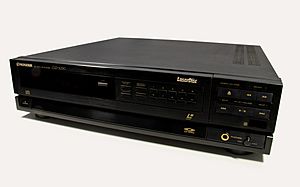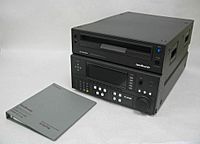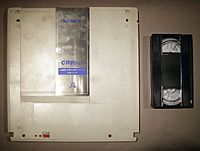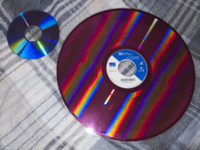LaserDisc facts for kids
| LaserDisc.svg | |
|---|---|
| LDDVDComparison-mod.png
A LaserDisc (left), with a DVD for size comparison, respectively with 30 cm (12 in) and 12 cm (4.7 in) of diameter
|
|
| Media type | Optical disc |
| Encoding | NTSC, PAL |
| Capacity | 60/64 minutes per side on CLV discs (NTSC/PAL); 30/36 minutes per side on CAV discs (NTSC/PAL) |
| Read mechanism | 780 nm wavelength semiconductor laser (early players used HeNe gas lasers) |
| Write mechanism | Laser on dye; same write mechanism as recordable CD/DVDs |
| Standard | LaserVision |
| Developed by | Philips, MCA Inc., Pioneer Corporation |
| Usage | Home video (replaced by DVD) |
| Extended to | DVD |
The LaserDisc (LD) was a special type of disc used for watching movies at home. It was the very first commercial disc that used a laser to read information. It first came out in the United States in 1978. LaserDiscs were quite large, usually about 30 cm (12 in) across. Unlike modern DVDs, LaserDiscs stored video using older analog signals, not fully digital ones.
Even though LaserDisc offered better picture and sound than VHS and Betamax tapes, it wasn't very popular in North America. This was mainly because the players and discs were expensive. Also, you couldn't record TV shows on them. However, it did become somewhat popular in the 1990s. It was not a common format in Europe or Australia.
In Japan and parts of Southeast Asia, like Hong Kong, LaserDisc was much more popular. Its great video and audio quality made it a favorite among movie lovers. The ideas and technology behind LaserDisc helped create later disc formats. These include the Compact Disc (CD), DVD, and Blu-ray discs.
Contents
History of LaserDisc
How LaserDisc Technology Began
The idea for optical video recording, using a clear disc, started in 1963. It was invented by David Paul Gregg and James Russell. Their patents were bought by a company called MCA in 1968. By 1969, Philips had also developed a similar disc. MCA and Philips then worked together. They first showed their video disc to the public in 1972.
When LaserDisc First Appeared
LaserDisc first went on sale in Atlanta, Georgia, on December 11, 1978. This was two years after the VHS video recorder came out. It was also four years before the CD, which uses similar laser technology. At first, it was called MCA DiscoVision. Before that, it had other names like Optical Videodisc System.
Pioneer Electronics later bought most of the rights to the format. They marketed it as LaserVision (the format name) and LaserDisc (the brand name) starting in 1980. Philips made the players, while MCA made the discs. Their partnership didn't last long.
LaserDisc was launched in Japan in October 1981. About 3.6 million LaserDisc players were sold there before they stopped making them in 2009.
Storing Digital Information
In 1984, Sony created a LaserDisc that could store any kind of digital data. It was like a CD-ROM but much bigger. It could hold 3.28 GB of data. This was a huge amount, similar to the DVD-ROM format that came out 11 years later.
Last LaserDisc Releases
The first LaserDisc movie sold in North America was Jaws in December 1978. The last one was Bringing Out the Dead in October 2000. Movies continued to be released in Japan until September 2001. The very last known LaserDisc was a karaoke disc released in March 2007. Pioneer stopped making LaserDisc players in July 2009. They continued to fix players until September 2020.
In 1998, about 2% of homes in the U.S. had LaserDisc players. In Japan, it was 10% of homes in 1999. Pioneer sold 9.5 million LaserDisc players worldwide.
By 2001, DVDs had completely replaced LaserDisc in North America. The format is still popular with collectors in America and even more so in Japan. In Europe, LaserDisc was always rare. The British Broadcasting Corporation (BBC) used LaserDisc for a big school project in the 1980s. They also used it for their TV channel logos in the 1990s.
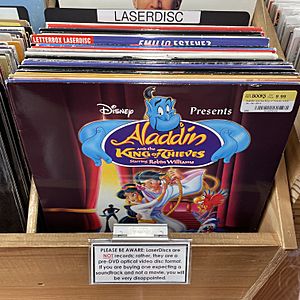
How LaserDiscs Were Designed
A normal home video LaserDisc is 12 in (30 cm) wide. It's made of two aluminum discs covered in plastic. Even though they look like CDs or DVDs, early LaserDiscs stored video in an analog way. This means the video signal was continuous, like an old TV signal. They also had analog FM stereo sound and some digital sound.
LaserDiscs were recorded with tiny pits and flat areas, just like CDs and DVDs. But on a LaserDisc, the information was stored as analog frequency modulation. This means the lengths and spacing of the pits changed to represent the video signal.
Later LaserDiscs added digital stereo sound, like CDs. They also added multi-channel sound formats like Dolby Digital and DTS.
Disc Rotation Speeds
Since digital video wasn't common in 1978, LaserDiscs used three ways to encode information based on how fast the disc spun:
- CAV
- Constant Angular Velocity discs were also called Standard Play. They allowed for cool features like freeze frame, slow motion, and playing in reverse. CAV discs spun at a steady speed (1800 rpm for NTSC discs). Each spin read one video frame. This meant you could store 54,000 individual frames on one side. That's about 30 minutes of video. A neat thing about CAV was that you could jump to any specific frame number. This was great for movie fans or students.
- CLV
- Constant Linear Velocity discs were called Extended Play. They didn't have the special features of CAV discs. However, they could store more video. CLV discs slowed down as they played (from 1800 to 600 rpm for NTSC). This allowed them to hold 60 minutes of video per side, or two hours per disc. Most movies were released on CLV discs because they fit on fewer discs.
- CAA
- In the early 1980s, Pioneer introduced Constant Angular Acceleration (CAA). This was to fix problems with CLV discs. CAA is like CLV, but the disc's speed changes in controlled steps. This improved picture quality and reduced issues. Most LaserDisc makers adopted CAA.
Pioneer also improved CAA when they added digital audio in 1985. Different CAA versions allowed for slightly different playing times per side.
Sound on LaserDiscs
LaserDiscs could store sound in either analog or digital formats. They also supported different surround sound formats. NTSC discs could have two analog audio tracks and two digital audio tracks. PAL discs usually had two tracks, either analog or digital. The digital sound was high-quality, like a CD.
Dolby Digital and DTS are common on DVDs today. But they first appeared on LaserDisc. To hear Dolby Digital from a LaserDisc, you needed a special player and an extra device called a demodulator.
The sound quality of digital audio on LaserDiscs was excellent for its time. It was much better than videotapes. However, the quality of analog sound varied a lot. Many early players and discs had poorer analog sound. Later analog discs used CX noise reduction to improve sound quality.
On DTS discs, digital PCM audio wasn't available. So, if you didn't have a DTS decoder, you had to use the analog sound tracks. Sometimes, these analog tracks were used for things like director's commentary instead of the movie's sound.
A full LaserDisc setup for surround sound needed a player that could handle digital and AC-3 audio. It also needed an external AC-3 demodulator and a DTS decoder.
PAL LaserDiscs played a bit longer than NTSC discs. But they had fewer audio options. PAL discs only had two audio tracks, either analog or digital. NTSC discs could have four tracks (two analog and two digital).
LaserDisc Players

Early LaserDisc players used large gas lasers. These lasers produced a red-orange light. Later players used smaller, solid-state laser diodes. These lasers produced an infrared light.
In March 1984, Pioneer released the first player with a solid-state laser, the LD-700. It was also the first player that loaded discs from the front, not the top. After this, gas lasers were no longer used in home players.
Most LaserDisc players required you to manually flip the disc to play the other side. However, some players could play both sides automatically. They did this by flipping the laser inside.
Pioneer also made players that could hold many LaserDiscs, sometimes more than 50. One company even offered a "LaserStack" unit in 1984. This unit could add multi-disc ability to existing players. It held up to 10 discs and could load or change sides automatically.
The first mass-produced industrial LaserDisc player was the MCA DiscoVision PR-7820. This player was used in many General Motors dealerships for training videos.
Most players made after the mid-1980s could also play Compact Discs. These players had a special spot for a CD on their loading tray. Some Pioneer models could even act as a CD changer.
The Pioneer DVL-9, released in 1996, was the first player that could play both LaserDiscs and DVDs.
The Pioneer HLD-X0 was the first player for high-definition video. A later model, the HLD-X9, had even better features.
Famous LaserDisc Players
- Pioneer PR7820: The first industrial LaserDisc player. It could be controlled by a computer. It was used in the first U.S. LaserDisc arcade game, Dragon's Lair.
- Pioneer CLD-1010: The first player that could play 5-inch (130 mm) CD-Video discs. It came out in 1987.
- Pioneer LaserActive players: These players could play Sega Genesis and TurboGrafx16 video games with extra parts.
- Pioneer DVL series: These players could play both LaserDiscs and DVDs.
LaserDisc Branding
During its development, MCA, which helped create the technology, called it by different names. In 1969, it was named Disco-Vision, and then in 1978, DiscoVision. MCA owned a huge library of films. They made and sold DiscoVision movies under the "MCA DiscoVision" label. Sales began in December 1978 with the movie Jaws.
Philips called their version "VLP," which stood for Video Long-Play. The first home player, the Magnavox VH-8000, even had the VLP logo. For a while, the format had no official name. The LaserVision Association was formed to set technical standards. They finally named the system "LaserVision."
After its launch in Japan in 1981, the format came to Europe in 1983 as LaserVision. Sales were low there. Philips tried to relaunch it as "CD-Video" in 1987. This name appeared on new smaller discs and on standard LaserDiscs with digital audio. In the early 1990s, the format's name changed again to LaserDisc.
Pioneer's Role in Branding
Pioneer Electronics joined the optical disc market in 1977. They partnered with MCA to make industrial players. When Pioneer launched their first player in 1980, it was called a "laser disc player." By 1981, "LaserDisc" was used for the discs themselves. Pioneer reminded magazines and stores that LaserDisc was a trademarked word.
On single-sided LaserDiscs made by Pioneer, if you played the wrong side, a funny image would appear. It was a happy, upside-down turtle with a LaserDisc as its belly. Below it, the words said: "Program material is recorded on the other side of this disc." This image was nicknamed the "LaserDisc Turtle."
MCA's Disc Releases
In the early years, MCA also made discs for other companies like Paramount and Disney. After DiscoVision Associates closed in 1982, Universal Studio's video label, MCA Videodisc, re-released many DiscoVision titles. Some of these re-releases were shorter versions of the originals. For example, the re-issue of Jaws had different background music due to high licensing costs.
How LaserDisc Compared to Other Formats
LaserDisc vs. VHS
LaserDisc had several benefits over VHS tapes. It offered a much sharper picture. LaserDisc had 425 lines of resolution for NTSC discs, while VHS only had 240 lines. Super VHS, released in 1987, improved VHS quality but still wasn't as good as LaserDisc for color.
LaserDisc could handle both analog and digital sound. VHS was mostly analog. NTSC LaserDiscs could even store multiple audio tracks. This allowed for extra features like director's commentary. You could also jump to any chapter on a LaserDisc quickly. VHS tapes required slow rewinding or fast-forwarding.
LaserDiscs were initially cheaper to make than videocassettes. This is because they had fewer parts and a simpler duplication process. A disc could be made in seconds. However, by the late 1980s, videocassettes became much cheaper to duplicate.
LaserDiscs also lasted longer than videocassettes. Since a laser read the discs, there was no physical contact. This meant playback wouldn't wear out the disc. VHS tapes, however, wore down with each use because the tape touched the player's heads. Tapes were also delicate and could easily be damaged.
LaserDisc vs. DVD
By the time DVDs came out, LaserDisc was not as popular. So, they didn't directly compete much.
LaserDisc used an analog video signal. This meant that color and brightness information were mixed. While good players could separate them, it wasn't perfect. DVDs, on the other hand, stored images digitally. This resulted in much clearer pictures, especially with fine details or strong colors.
LaserDiscs used analog video and no compression. This meant they didn't have issues like "macroblocking" (blocky images) or "color banding" (visible lines in color gradients) that DVDs could sometimes have due to digital compression. Early DVDs sometimes only matched LaserDisc quality. But by the end of LaserDisc's time, DVDs were clearly better.
DVDs use compressed audio formats like Dolby Digital and DTS for surround sound. Most LaserDiscs had high-quality digital stereo audio tracks. DTS-encoded LaserDiscs actually had higher quality DTS sound than what was common on DVDs.
Advantages of LaserDisc
LaserDisc players gave users a lot of control. You could always pause, fast-forward, or fast-reverse. There were no "User Prohibited Options" that stopped you from skipping parts, unlike some DVDs.
With CAV LaserDiscs, you could jump directly to any frame by typing its number. This feature is rare on DVD players.
Damaged spots on a LaserDisc could often be played through or skipped. A DVD might stop playing completely if it had damage. LaserDisc players recovered from errors faster.
Some movie fans felt that LaserDisc had a "smoother" or more "film-like" picture than DVD. Early DVDs sometimes had compression problems, which supported this idea. However, DVDs generally looked sharper and clearer to most people.
Another benefit was that anti-piracy technology was optional. It was hard to apply Macrovision copy protection to LaserDisc. The format's design used the space where the copy protection signal would go for other things. Because LaserDisc had a small market, there wasn't a big push to redesign it for copy protection.
LaserDisc's support for multiple audio tracks allowed for lots of extra content. It was the first format for "Special Edition" releases. The 1984 Criterion Collection edition of Citizen Kane is seen as the first "Special Edition" home video release. It included interviews, commentary, documentaries, and photos.
Disadvantages of LaserDisc
Despite its advantages, LaserDiscs had some downsides. The discs were heavy, weighing about 250 grams (8.8 oz) each. They were also large and easily damaged if not handled carefully. Manufacturers didn't sell LaserDisc players that could record, unlike VCRs. Because of their size, players made more noise when spinning the discs.
The analog video signal on a LaserDisc took up a lot of space. This limited playback time to 30-36 minutes per side for CAV discs, or 60-64 minutes per side for CLV discs. After one side finished, you had to flip the disc over. Some movies even needed two or more discs. Many players could flip discs automatically, but this caused a pause in the movie.
Also, perfect still frames and jumping to specific frames were only possible with the more expensive CAV discs. These discs only played for about 30 minutes per side. Later, some players used a digital memory buffer to create still frames from CLV discs.
LaserDiscs didn't have built-in error correction like digital formats. So, small dust or scratches could cause glitches, streaks, or picture interruptions. DVDs, with their digital error correction, would play perfectly until the damage was severe.
Another problem was "crosstalk." This happened when the laser read information from a track next to the one it was supposed to. It caused distortion in the picture, like swirling lines. This could happen if the player was out of alignment or the disc was damaged.
Playback quality also varied a lot between different LaserDisc players. A cheap player might give a much worse picture than an expensive one. This was not as big an issue with DVD players.
What is Laser Rot?
Many early LaserDiscs were not made correctly. The glue used had impurities that could damage the metal layer inside the disc. This problem was called "laser rot" by fans. It caused the recorded signal to get worse. Sometimes, laser rot appeared as black spots. But often, rotted discs looked fine to the eye.
Later disc formats also had similar problems, like some defective CDs made in the late 1980s.
Impact and Decline of LaserDisc
LaserDisc didn't sell well in North America. This was because players and discs were expensive, much more than VHS. Also, people were confused by another disc format called CED. Even so, movie fans loved LaserDisc for its great audio and video quality. By 1990, nearly a million American homes had a LaserDisc player.
The format was more popular in Japan. Prices were kept low there, so LaserDiscs weren't much more expensive than VHS tapes. This helped it become the main home video format in Japan. Anime collectors also liked LaserDisc for its better quality and many titles not on VHS. LaserDiscs were also popular in Southeast Asia because they lasted longer than videotapes in humid weather.
In Hong Kong, LaserDisc was very popular in the 1990s. People often rented discs, which cost about US$100 to buy. This helped the video rental business grow.
Even though it was popular in some places, manufacturers didn't sell LaserDisc recorders to consumers. This was a big disadvantage compared to VCRs, which could record. The large disc size, high cost, and lack of recording hurt sales worldwide.
By the late 1990s, DVD had replaced LaserDisc. However, many LaserDisc titles are still wanted by movie fans. This is because some films are only available on LD. Also, many LD releases have extra features not found on later DVD versions. Until 2001, many titles in Japan were released on VHS, LD, and DVD.
Other Uses and Developments
LaserDisc in Video Games
The LaserDisc's ability to instantly jump to different parts of the disc made it great for a new type of video arcade game. In the 1980s and 1990s, companies like Cinematronics and American Laser Games made interactive movie games. Famous examples include Dragon's Lair and Space Ace. Home video game consoles like the Pioneer Laseractive also used LaserDisc for their games.
Special LaserDisc Types
- MUSE LD
- In 1991, a new type called MUSE LaserDisc came out. These discs stored high-definition video. They used a special red laser that could read through scratches better. MUSE players could also play regular NTSC discs. However, MUSE players and discs were very expensive and mostly sold in Japan.
- Picture discs
- These discs had artistic designs etched on one side. This made them look more attractive. Sometimes, this side was made with colored plastic. Picture discs only had video on one side, as the "picture" side couldn't hold data. They are rare in North America.
- LD-G
- Pioneer Electronics used LaserDiscs for karaoke in Japan. This format was called LD-G. It stored music and graphics for karaoke songs.
- Anamorphic LaserDiscs
- When 16:9 widescreen TVs became available, Pioneer and Toshiba made "Squeeze LDs." These discs stored movies in a "squeezed" format. This meant the widescreen image filled the whole video frame, using more of the disc's resolution. This is similar to how anamorphic DVDs work. However, very few LD players could "unsqueez" the image for older 4:3 TVs. So, if played on a regular TV, the image would look stretched. These discs were rare outside of Japan.
Recordable LaserDiscs
There were also recordable LaserDisc formats, but they were mostly for professionals.
- CRVdisc
- Developed by Sony, these were "Component Recordable Video Discs." They looked like large CD-ROMs in a caddy. CRVdiscs were "write-once, read-many" media. This means you could record on them once, but not erase and re-record. They were used for backup storage.
- RLV
- The Recordable Laser Videodisc (RLV) was developed by Optical Disc Corporation in 1984. RLV discs were also "write-once" and looked almost exactly like regular LaserDiscs. They had a reddish color because of the dye used to make them recordable. RLV discs could play in any standard LaserDisc player after being recorded. They were popular for making small numbers of discs for special uses, like interactive kiosks.
Pioneer also made a rewritable LaserDisc system called the VDR-V1000. Its discs could be erased and recorded up to a million times.
These recordable systems were never sold to the general public. This led to the idea that home recording on LaserDiscs was impossible.
-
A CRVdisc with a VHS tape for size comparison
-
A Recordable Laser Videodisc with a DVD-R for size comparison
LaserDisc Sizes
30 cm (Full-size)
The most common LaserDisc size was 30 cm (11.8 in). This is about the same size as a 12-inch LP vinyl record. These discs could hold 30-36 minutes per side (CAV) or 60-64 minutes per side (CLV). Most LaserDisc movies were released on these full-size discs.
20 cm ("EP"-size)
Some 20 cm (7.9 in) LaserDiscs were also made. These smaller discs could hold 20 minutes per side (CLV). They are much rarer, especially in North America. They are about the size of a 45rpm vinyl single. These discs were often used for music video collections or Japanese karaoke machines.
12 cm (CD Video and Video Single Disc)
There were also 12 cm (4.7 in) discs, the same size as a CD. These were called CD Video (CD-V) discs and Video Single Discs (VSD). They could be played on LaserDisc players.
CD-V was a mix format launched in the late 1980s. It had up to five minutes of analog LaserDisc-type video with digital sound. It also had up to 20 minutes of regular audio CD tracks. CD-Vs were somewhat popular for a short time.
The VSD format came out in 1990. It was similar to the 12 cm CD-V, but without the audio CD tracks. VSDs were popular only in Japan and parts of Asia.
See also
 In Spanish: Laserdisc para niños
In Spanish: Laserdisc para niños




